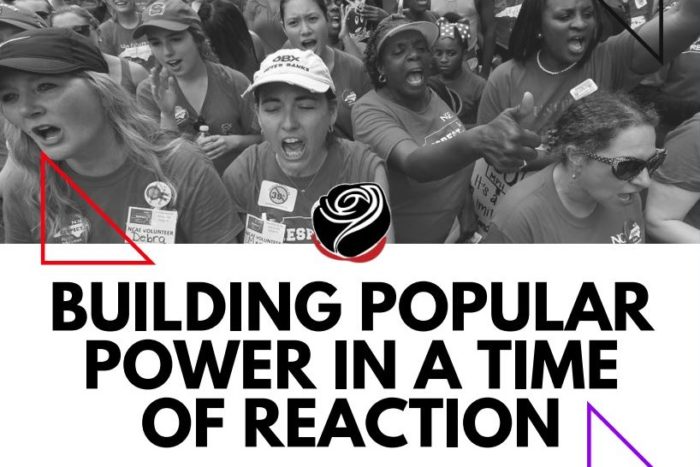
Editorial Note: This piece builds upon and updates the strategy and analysis document “Below and Beyond Trump” we released in late 2017 and aims to capture a snapshot of our internal discussions and conclusions over the past year. Because these conversations began in the lead up to our National Convention in early August we were not able to incorporate some more recent events and especially the feminist analysis developed in the statement “Kavanaugh and a Feminist Movement Fighting to End Capitalism” and which draws upon the article “A Feminist Movement to End Capitalism, Part I (Part II forthcoming). We recommend reading these pieces in addition to this. #PowerFromBelow #BuildPopularPower
Popular Power In a Time of Reaction: Strategy for Social Struggle
Strategy and Analysis / Análisis de Coyuntura Document
Prepared by members of the BRRN Analysis and Strategy Committee and approved by the membership.
Versión Español de este documento
Download a PDF pamphlet: English / Spanish
Last year in “Below and Beyond Trump: Power and Counterpower,” we argued that the U.S. ruling class is in the midst of a destabilizing political crisis, leading to increasing politicization and polarization across the country, and that the Trump regime is both a symptom and a cause of the current divisions playing out at the top of the political food chain. In response to the rise of Trump, we noted that social movements, particularly those driven by the “institutional left” (nonprofits, business unions, etc), have been characterized by retrenchment, militant reformism, and a sharp turn toward electoral politics. In this context, we highlighted the growing potential for advancing a libertarian socialist vision and strategy that speaks to the needs and desires of the current moment.
In this follow up to Below and Beyond Trump, we will briefly highlight recent expressions of the dominant trends that characterize the current social, political and economic landscape and outline a strategic orientation for building popular power and advancing social movements toward libertarian socialism. Our argument is simple, that we need to move from “protest” to building popular power. We define popular power as creating independent institutions and organizations of the working class to fight white supremacy, patriarchy and capitalism. Whether in workplaces, neighborhoods, prisons, or schools, building organizations in these sites can help movements build power and transform the current tide of right politics. With a focus on organizing, movements can win not only meaningful reforms, but create a path toward a libertarian socialist society.
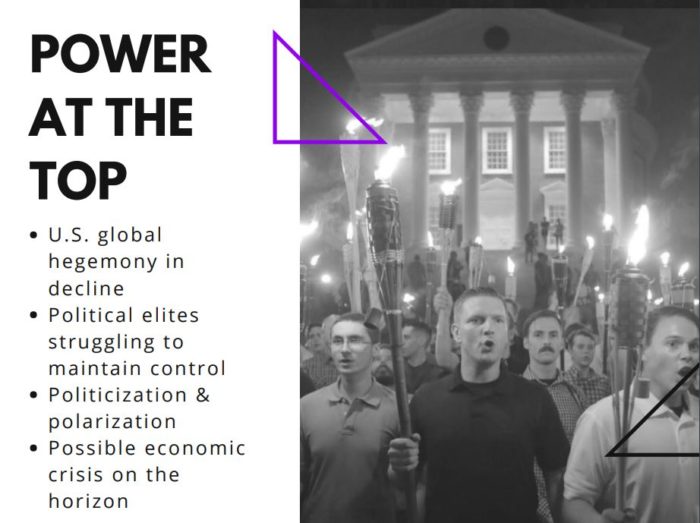
Power at the Top
In the realm of foreign policy, Trump has represented a huge step backward for US global leadership. In a whole number of strategic areas, Latin America, the Middle East, Africa, Europe and Asia, the US role as global economic, diplomatic, and military leader is on the wane (although still in the top position). Perhaps this is nowhere more evident than in Europe, where US leadership in NATO and the G7 is under serious strain. Sometimes this can open the door for the aims of anti-militarist movements such as the case with the Korea peace process. But this can also be dangerous, for example in Syria where Trump has allowed horrendous atrocities by Assad and US ally Turkey.
In many of these moves, we find the Trump administration’s behavior inexplicable. For example, in the emerging trade war with China, Canada, and European powers, the imposition of $34 billion in tariff protections defies longstanding elite consensus on global trade. In making this move the Trump administration has angered many powerful corporate sectors of US society, who stand to lose billions of dollars, and have been vocal in their opposition to the trade tariffs. Why this isn’t enough to stop the policy is unclear, as are the motives for it in the first place. China is emerging as an economic power that is beginning to rival the United States, although in military capacity the US still dwarfs the rest of the world. The tariffs could be a way to counter the economic rise of China, or an ideological and racist move for which economic factors are less significant. But it points to a highly unpredictable and maverick leadership, and because of this many establishment liberals are adamant in the necessity to oust Trump.
In the domestic realm, Trump’s positions, as odious as they are, have largely stayed within the scope of neo-liberal practice of state management. He continues to roll back the Keynesian New Deal state much like Obama and Bush before him. Numerous environmental, labor, and civil rights protections have been abandoned by the administration. In budgetary priorities, the Trump administration has granted the Pentagon its largest funding priority ever, exceeding even the requests from US military planners, and at the same time is imposing and proposing some of the harshest cuts on social services in recent memory, all while cutting taxes on the very rich. For example, bedrock programs of the New Deal state like Social Security and Medicaid are under serious threat. Meanwhile, the Trump administration has appointed a series of semi-criminal elements that have been forced to resign, and some like Dinesh D’souza and Sheriff Joe Arpaio the president has personally pardoned.
In all this, it appears that the Trump administration has little concern for the “legitimation” function of the state, which is a basic role of government to build support for established centers of authority and capital. Instead he is strengthening and expanding the authoritarian elements devoted to violence. The two best examples of this are the family detention and separation policy imposed by Trump advisor Stephen Miller and the Muslim ban recently approved by the Supreme Court. These come as huge shocks to the liberal establishment, but here too build off policies of Obama and other centrists. This lack of legitimation, and widespread corruption within his administration may lead to his impeachment. The recent indictments and convictions of close Trump aids increases this likelihood. If these scandals move toward impeachment, it will be a major test of the constitutional resilience of the liberal institutions of governance and will be important to watch closely.
A further potential disruption on the horizon is the possibility of economic destabilization and depression. While the capitalist class and the corporate sector are exploding with wealth, the rest of the country never recovered from the 2008 financial crisis. This dynamic echoes the economic inequality and tensions of the 1920s that led to the historic 1929 market crash and resultant depression. No one can tell the future, but there are worrying signs on the horizon like the slowdown in the housing market, and the “inversion” of bond rates spelling trouble for long term investments. If there is a recession or depression it would significantly change the organizing terrain before us.
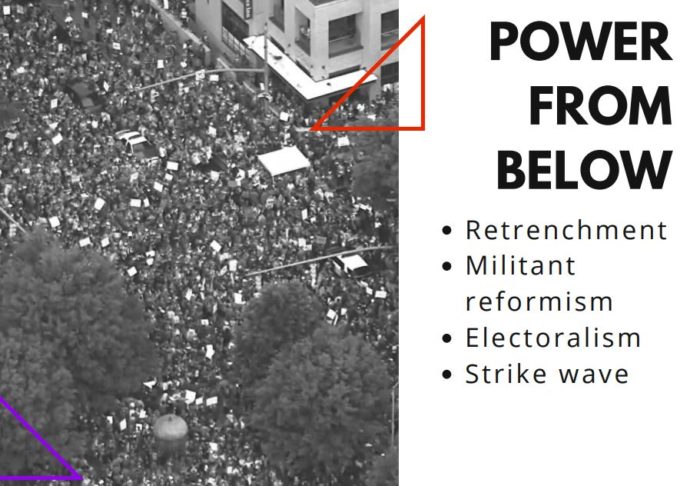
The State of Popular Power
Social movements have been disoriented and have responded in ways we laid out in our Below and Beyond Trump strategy document from 2017. US social movements are comparatively weak when examined from an international perspective. This means that movements here must organize at a much more basic level than those in other countries to build the capacity for mobilization and empowerment. Even so, with the election of Trump movements have become more cautious and shifted efforts into electoral campaigns.
Many movements have been forced or voluntarily moved to a defensive footing. This is especially true for the “institutional left” – unions, non-profits, and those with institutional interests to protect and preserve. Unions in particular have been flat footed in the response to significant existential threats like the recent Janus ruling and the declared offensive by very large and well-funded business groups. Other NGOs have also been unable or unwilling to respond to the clamor for more activism and resistance against Trump. For example, organizations like the ACLU their “membership has grown from 400,000 to 1.84 million so far during the course of Trump’s presidency. And while it usually brings in an average of $3-$5 million each year, during these first excruciating 15 months it has raised almost $120 million in online donations.” Yet that growth has not translated at all into the power necessary to resist Trump and his authoritarian version of neoliberalism.
For more dynamic social movements, the current moment reflects a mixed bag. In 2016 many social movements including environmental activism, the BLM movement and others were ascendant. The momentum has definitively shifted against them under Trump, but not all movements. For example two dramatic and powerful direct action movements emerged in the shadow of Trump, the #MeToo and the Parkland students movement against gun violence. Both of these show the dramatic power of direct action, mass disruptive movements focused on power. For #MeToo, several powerful men, many of them employers, have had their careers ended by the social media campaigns against sexual assault and sexual violence. For the Parkland students, their national protests (the first wave of school walkouts and disruptive actions, not the milquetoast efforts co-opted by the Democrats) forced major Republican figures to change their positions on guns, and in Florida to enact some modest though ultimately reactionary reforms. These are exactly the types of mobilizations we predicted as militant reformism as popular opposition pushes against institutional boundaries and forces legislative and social change within very narrow, liberal, confines.
These efforts have also quickly been diverted from their more militant and disruptive forms of protest into electoral channels either inside or outside the Democratic Party. For the left the largest phenomenon here is the rise of the Democratic Socialists of America, a political organization now with a reported 50,000 membership base, and one with significant impacts on movement strategy and direction, drawing people into electoral efforts. Their biggest victory was the recent primary win and successful election of Alexandria Ocasio Cortez in Queens New York who beat out an entrenched Democratic incumbent to win a seat in the House of Representatives. There are also efforts among liberals and progressive elements to redouble electoral organizing. Most notable here is the move by BLM founder and movement leader Alicia Garza to build a Black voting base called Black Futures Lab, who just endorsed their first candidate Ilhan Omar, to replace Keith Ellison in Minnesota. We expect to see more of these moves to electoralism and see it as a major step backward for social movement strategy for reasons we have explained elsewhere.
However, the most significant and surprising development of the last year for social movements was the emergence of a militant rank-and-file teachers movement. This movement deserves more careful study from our organization, but it has achieved impossible gains in a very short time, and BRRN members have been active organizing here. Most notable is that through labor action in the workplace, strikes, walkouts and sickouts, the teachers have forced major gains, as much as 20% pay increases and expanded state funding for schools, on some of the most reactionary Republican legislators and administrators in the country. Notably, they also did this by organizing under, over, around and through their union leadership, sometimes bringing them along to the fight, at other moments having to circumvent the leadership entirely, and vote against official recommendations for conciliation. They built power outside of established channels, used small actions to build for strikes that were meaningful, and actually shut down their workplaces. Another example of worker militancy is the Burgerville Worker Union, the first fast food union in the United States organized by rank-and-file militants. Again BRRN members are active here and their approach highlights the failing strategy of the major unions and NGOs. One aspect of the rank-and-file organizing is the spark of confidence by workers that realize the potential of their power and that they can win is a huge victory for working people. These developments are a major step forward and a model we should look to in our organizing.
A movement that deserves mention are the deep and growing immigrants organizing networks. Whether around rank-and-file workplace militancy or direct defense against deportations organizers are working to strengthen immigrant communities. Trump’s shocking policy of family separation was built on Obama era policies of family detention, and galvanized much of this popular push back. But again, the large NGO mobilizations have yielded disappointing results, where on the ground direct action is having a much larger impact. One example we would point to is the Koreatown Popular Assembly (KPA) of Los Angeles, a project that BRRN members are helping organize. The KPA has used technology that allows them to rapidly respond, alert and mobilize community members in response to ICE activity such as raids and detentions. Here there is a connection to mass incarceration, and again BRRN members are involved organizing the historic prison strike of August of this year, and building connections with immigrants detained in corporate deportation centers. It is through these engaged, on-the-ground organizing and direct action campaigns that we can push back against the right-ward tide of American politics. Meanwhile, efforts tied to the institutional left are failing to adequately face this challenge.
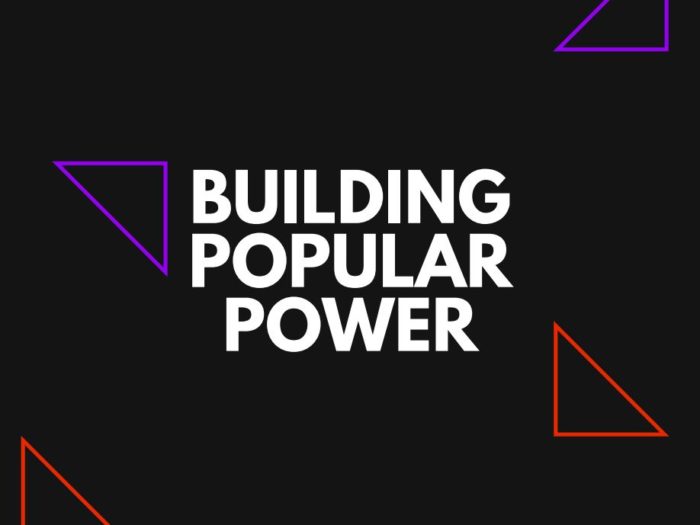
Practical Strategy for Building Popular Power
Our vision for building popular power to both stop the advance of the right and create transformative change to build the libertarian socialist society is detailed here. We advocate a strategy that focuses on building popular organizations and institutions of community control. Building popular power is meant to build autonomous organizations for and run by working class people to realize their political power, which is in contrast to power negotiated between those in the state political arena and directed by professionalized staff. In any sector, it means we must organize; this involves building small nuclei of organizers, engaging with movements on a direct action basis, and scaling up those projects to mass participation. There are further steps after this that are necessary, for example building organizational structures that are resilient and flexible enough to remain both mass oriented and combative in nature, but for now we will focus on local militant activity and how to build popular power.
In the last 18 months we have heard an increasing call that social movements should move “from protest to politics.” Typically this means that street demonstrations of #BlackLivesMatter or anti-fascist organizers have limited efficacy, and to make lasting change activists must organize in electoral campaigns to support progressive mainstream politicians. We fundamentally disagree here. While we share the critique of activism and the limitations of mobilizations, we argue that a move to electoralism is a step backward because it does not build the independent power we need to win.
Instead, we argue that social movements build on the tremendous power of protest by organizing more deeply and more widely in different social sectors. Indeed, BRRN is considering adopting a sectoral strategy as the basis for our organizing work. We see social sectors as the people, social relationships and institutions that define our lives and experiences. For example, labor is a major social sector, a place where we spend most of our adult lives, where we generate profit for capitalists, and have established social networks and collective interests. Other organizing sectors we have identified are the neighborhood, in prisons and carceral institutions, and with students and education. Each of these sectors is a site of power, and movements can turn from disconnected mobilizations to organizing in these sectors to build popular power. We also see the need to highlight the intersectional and intersectoral nature of social struggle and social power.
Organizing 101
Whatever your movement work, building popular power means organizing. This is the process of bringing people together to impact the issues that concern them. Our model comes from labor organizing, and involves forming an organizing committee to take collective action. The committee can be small, between three and twenty persons, but with an emphasis on organizing and disruptive action it can have a huge impact. With a committee, organizers can bring more and more people into political action, and plan a direct action campaign targeted against power to win concessions. With success here, those projects can be scaled up to increased participation in mass mobilizations and mass direct actions, like strikes or sit-downs or civil disobedience, and a proliferation of the model.
This part of organizing we call “political layers” and are considering adopting as a formal strategic framework. Here we see three layers of social movement organizing, from the political layer, to the intermediate, and the mass layer. The political layer is the role of parties and political organizations like BRRN, and organizations that have clear political principles and objectives. In the above schema, the committee organizing takes place in the intermediate layer, a grouping with loosely shared objectives or tactics, with an eye toward building mass layer organizations and movements. We find this break down helps clarify and organize our tasks for supporting and sustain social movement organizing and transformative change.
Conclusions
With sectoral and political layer analysis, we still have many lingering questions and there has been significant internal discussion about our adopting these strategic frameworks. Most of the questions have to do with what gets left out, what are the intersections with identity and social oppression, and how we can use them in our organizing. For the time being, we argue that organizing within the arenas of our workplaces, neighborhoods, schools and where we are incarcerated can help take movements from “protest to politics,” but to a politics of different sort, not ones based on supporting politicians and building the institutions of capitalism, white supremacy, patriarchy and the status quo. Instead building popular power rooted in sites of struggle can help us win transformative gains, and help turn the course of history to a brighter future.
Fractures at the top provide opportunities for building power from below. It is our task to seize these opportunities and push forward movements for liberation.
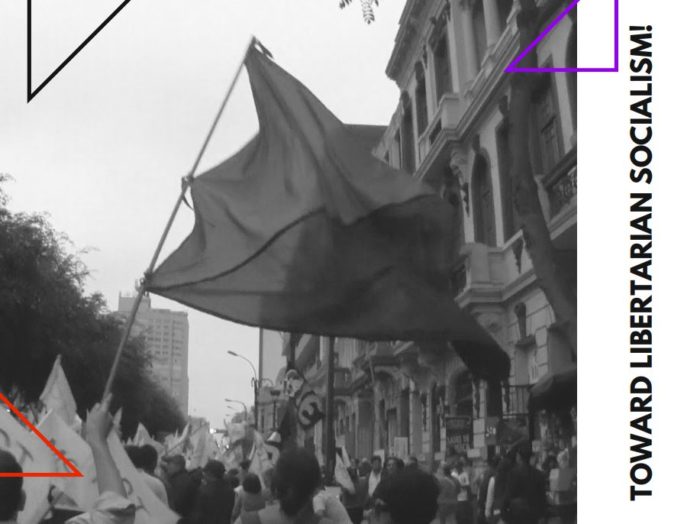
If you enjoyed this piece we recommend “Below and Beyond Trump: Power and Counterpower” which this piece builds upon. In addition we recommend the feminist analysis developed in the statement “Kavanaugh and a Feminist Movement Fighting to End Capitalism” which draws upon the article “A Feminist Movement to End Capitalism, Part I.”

